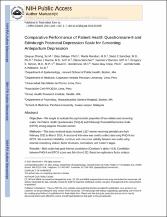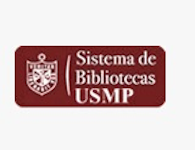Mostrar el registro sencillo del ítem
Comparative performance of patient health questionnaire-9 and edinburgh postnatal depression scale for screening antepartum depression
| dc.contributor.author | Zhong, Qiuyue | |
| dc.contributor.author | Gelaye, Bizu | |
| dc.contributor.author | Rondon, Marta | |
| dc.contributor.author | Sánchez, Sixto E. | |
| dc.contributor.author | García, Pedro J. | |
| dc.contributor.author | Sánchez, Elena | |
| dc.contributor.author | Barrios, Yasmin V. | |
| dc.contributor.author | Simon, Gregory E. | |
| dc.contributor.author | Henderson, David C. | |
| dc.contributor.author | Cripe, Swee May | |
| dc.contributor.author | Williams, Michelle A. | |
| dc.date.accessioned | 2020-07-08T15:59:26Z | |
| dc.date.available | 2020-07-08T15:59:26Z | |
| dc.date.issued | 2014-06-20 | |
| dc.identifier.citation | Zhong Q., Gelaye B., Rondon M., Sanchez SE., García PJ., Sanchez E., et al. Comparative performance of patient health questionnaire-9 and edinburgh postnatal depression scale for screening antepartum depression. J Affect Disord. 2014; 162: 1–7. | es_PE |
| dc.identifier.uri | https://hdl.handle.net/20.500.12727/6304 | |
| dc.description.abstract | Objective: We sought to evaluate the psychometric properties of two widely used screening scales: the Patient Health Questionnaire (PHQ-9) and Edinburgh Postnatal Depression Scale (EPDS) among pregnant Peruvian women. Methods: This cross-sectional study included 1517 women receiving prenatal care from February 2012 to March 2013. A structured interview was used to collect data using PHQ-9 and EPDS. We examined reliability, construct and concurrent validity between two scales using internal consistency indices, factor structures, correlations, and Cohen׳s kappa. Results: Both scales had good internal consistency (Cronbach׳s alpha>0.8). Correlation between PHQ-9 and EPDS scores was fair (rho=0.52). Based on exploratory factor analysis (EFA), both scales yielded a two-factor structure. EFA including all items from PHQ-9 and EPDS yielded four factors, namely, "somatization", "depression and suicidal ideation", "anxiety and depression", and "anhedonia". The agreement between the two scales was generally fair at different cutoff scores with the highest Cohen׳s kappa being 0.46. Conclusions: Both the PHQ-9 and EPDS are reliable and valid scales for antepartum depression assessment. The PHQ-9 captures somatic symptoms, while EPDS detects depressive symptoms comorbid with anxiety during early pregnancy. Our findings suggest simultaneous administration of both scales may improve identification of antepartum depressive disorders in clinical settings. | es_PE |
| dc.format.extent | pp. 1-7 | es_PE |
| dc.language.iso | eng | es_PE |
| dc.publisher | Elsevier B.V. | es_PE |
| dc.relation.ispartof | urn:issn:0277-9536 | |
| dc.relation.ispartofseries | Journal of Affective Disorders;vol. 162 | |
| dc.relation.uri | https://www.ncbi.nlm.nih.gov/pmc/articles/PMC4040145/ | es_PE |
| dc.relation.uri | https://doi.org/10.1016/j.jad.2014.03.028 | es_PE |
| dc.rights | info:eu-repo/semantics/openAccess | es_PE |
| dc.rights.uri | https://creativecommons.org/licenses/by-nc-nd/4.0/ | es_PE |
| dc.source | Repositorio Académico USMP | es_PE |
| dc.source | Universidad San Martín de Porres - USMP | es_PE |
| dc.subject | Depresión | es_PE |
| dc.subject | Cuestionario de salud del paciente | es_PE |
| dc.subject | Complicaciones del embarazo | es_PE |
| dc.subject | Embarazo | es_PE |
| dc.title | Comparative performance of patient health questionnaire-9 and edinburgh postnatal depression scale for screening antepartum depression | |
| dc.type | info:eu-repo/semantics/article | es_PE |
| thesis.degree.name | Medicina Humana | es_PE |
| thesis.degree.grantor | Universidad de San Martín de Porres. Facultad de Medicina Humana | es_PE |
| thesis.degree.discipline | Medicina | es_PE |
| dc.subject.ocde | https://purl.org/pe-repo/ocde/ford#3.02.00 | es_PE |
Ficheros en el ítem
Este ítem aparece en la(s) siguiente(s) colección(es)
-
Artículos [274]








